HoufyProtect: Incident Submission Guide & Best Practices
Discovering damage in your short-term rental property can be a stressful experience. We understand your concerns and have created this guide to help you navigate the incident submission process efficiently and effectively.
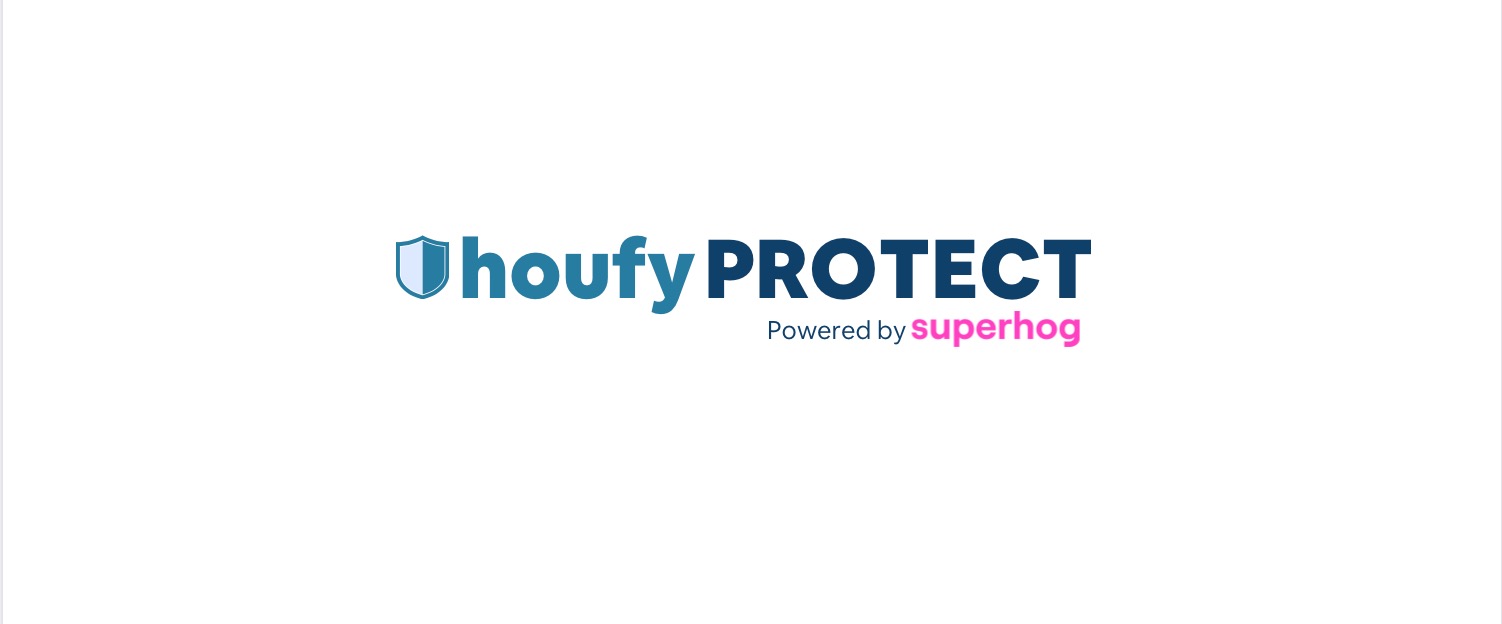
This page outlines the step-by-step process for submitting an incident report for guest-caused damage with Superhog and other important information about their processes.
By following these instructions and gathering the necessary evidence, you can maximise your chances of speedy and successful resolution and protect your valuable investment.
Whether you're dealing with minor or significant damage, HoufyProtect is here to support you throughout the process. Remember, prompt action and clear communication are key.
Important: Establishing Preventative measures
Establishing and communicating clear house rules is a fundamental step in safeguarding your property.
House rules comprise a set of guidelines dictating the expected behaviour of guests during their stay at the property. Hosts must articulate clear rules and ensure guests adhere to them.
A well-defined set of house rules serves as a preventive measure, helping avoid various issues such as property damage or disputes with neighbours.
Furthermore, it provides a framework for holding guests accountable if they violate any specified rules.
To streamline the process, guests should ideally review and accept the house rules before requesting a reservation. Displaying a printed copy of the rules in your rental or incorporating them into your digital welcome information is also a recommended practice.
Examples of such rules may include prohibitions on smoking or bringing pets onto the premises. By implementing and communicating these rules effectively, hosts can foster a positive and respectful environment for all guests.
Reporting the damage and initiating your report!
Access the incident submission form here. You will need to enter code "HOU001" at the resolution reference.
What is protected? Learn more here.
Upon discovering damage(s) at your property the following actions should be undertaken:
- If necessary, emergency repairs should be carried out to limit further damage, loss or injury – for example securing your home or stopping a water leak.
- In all situations, please undertake a full check of your home and catalogue any damage that has occurred during that stay/booking.
- Photographs should be taken as soon as possible – panoramic room shots and close-ups of damage (these steps can be completed by you, your cleaner or the relevant third party).
- Do not carry out any non-emergency repairs without checking with Superhog first.
- Do not dispose of any damaged items – they may be needed for inspection.
- Do not admit or allow the admittance of any liability or offer a settlement/make any deal or offer.
- For malicious damage or theft – report the damage/loss to the police and obtain a crime reference number/report.
- Contact the guest to discuss any damage or injury with them, and try and find out the circumstances of the incident. Wherever possible it is helpful to keep a record of any such communication.
Evidence requirements:
Ensuring fair and accurate resolutions for both hosts and guests requires objective evidence.
Submitting clear and comprehensive evidence plays a crucial role in verifying the nature and extent of the damage. This ensures Superhog can process your resolution efficiently and reach a fair decision based on tangible proof, not just individual accounts.
Additionally, proper documentation protects both parties by creating a transparent record of the incident and its resolution.
Photos showcasing the damage, repair estimates from qualified professionals, and communication records with the guest (where possible) all contribute to a swifter resolution.
Before and after pictures
Before:
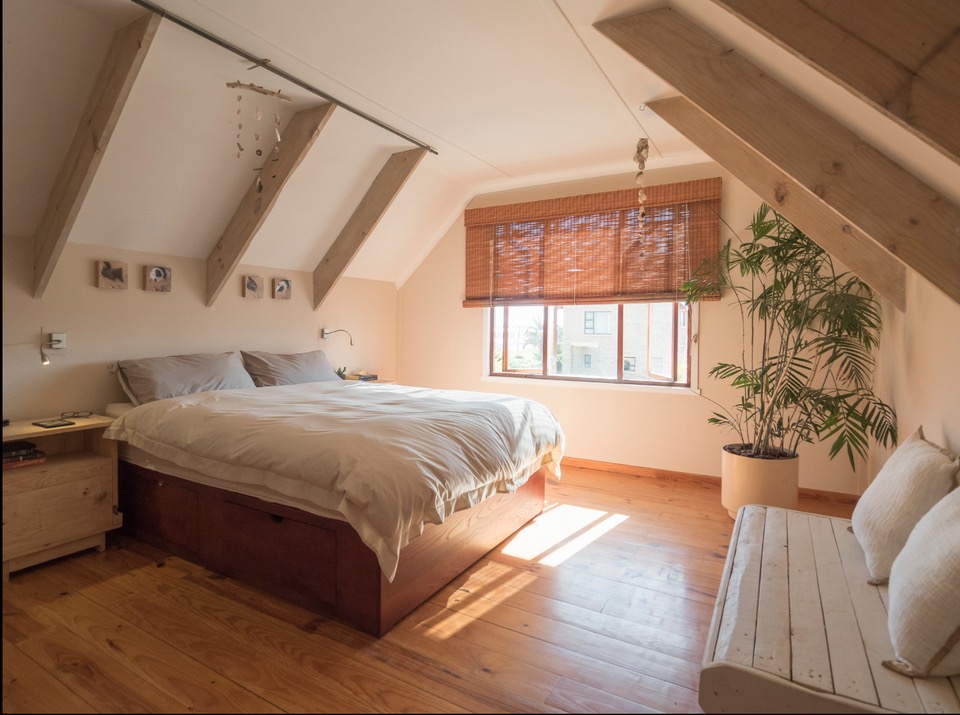
After:
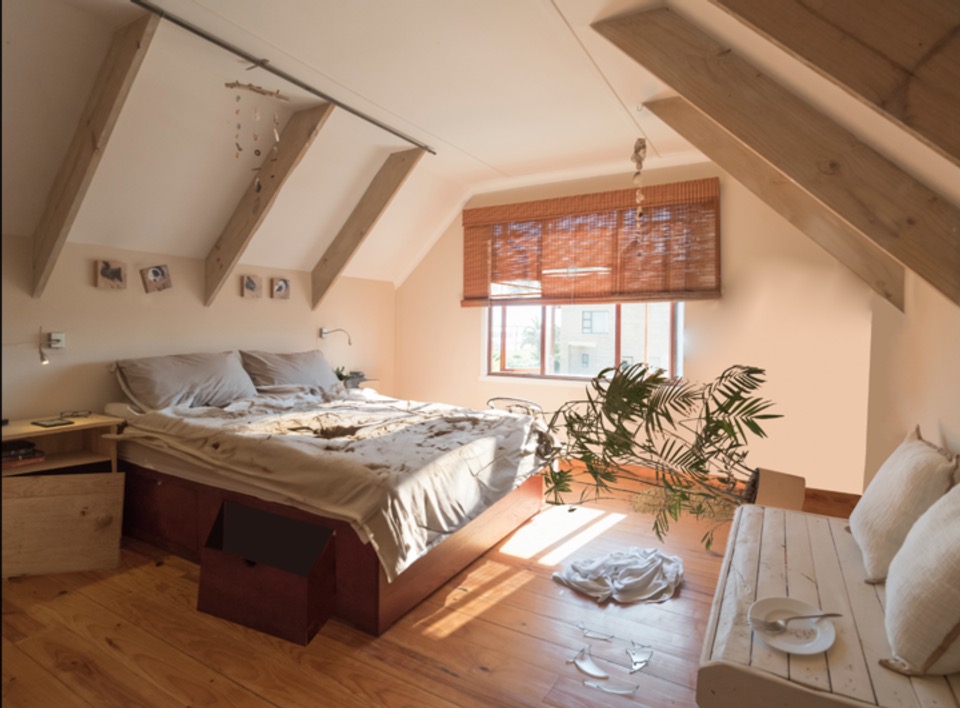
A guest might contend that any damage incurred during their booking is merely wear and tear or unrelated to their actions. In instances where the guest does not accept responsibility for damages, it becomes imperative to gather substantial evidence to establish their liability.
The absence of pre-stay photos makes it challenging to substantiate incidents. Time-stamped photographs serve as a highly effective means to document the condition of the property, its appliances, fixtures, furnishings, and any pre-existing wear and tear.
To maximise protection and enhance the likelihood of recovering damage costs, we strongly recommend capturing images upon arrival and replicating the same shots during checkout. This should include both wide-view shots and close-ups of specific furnishings.
While not always feasible, implementing this practice whenever possible provides an added layer of protection for property owners. These images can be conveniently taken during the cleaning process before and after each booking.
Timestamped pictures
- Establishing a timeline: Timestamps provide an accurate record of when an image was captured, offering a neutral and verifiable timeline of events. This can be essential for determining the sequence of events, identifying discrepancies in accounts, and establishing alibis.
- Authenticity verification: Timestamps embedded within the image file itself, rather than just added later, help to prevent tampering or manipulation. This is crucial for maintaining the integrity of the evidence and ensuring its reliability in the resolution process.
- Identifying changes: With accurate timestamps, any changes in the scene or object captured in the image can be identified by comparing images taken at different points in time. This can be crucial for understanding the development of an incident and verifying statements about changes made.
How to Retrieve Time Stamps:
- Take a photo
- Go to your gallery
- Select the relevant image
- Press the ℹ️ at the bottom of the screen
- The timestamp will be revealed. Send a screenshot of the image with the timestamp included.
Iphone:
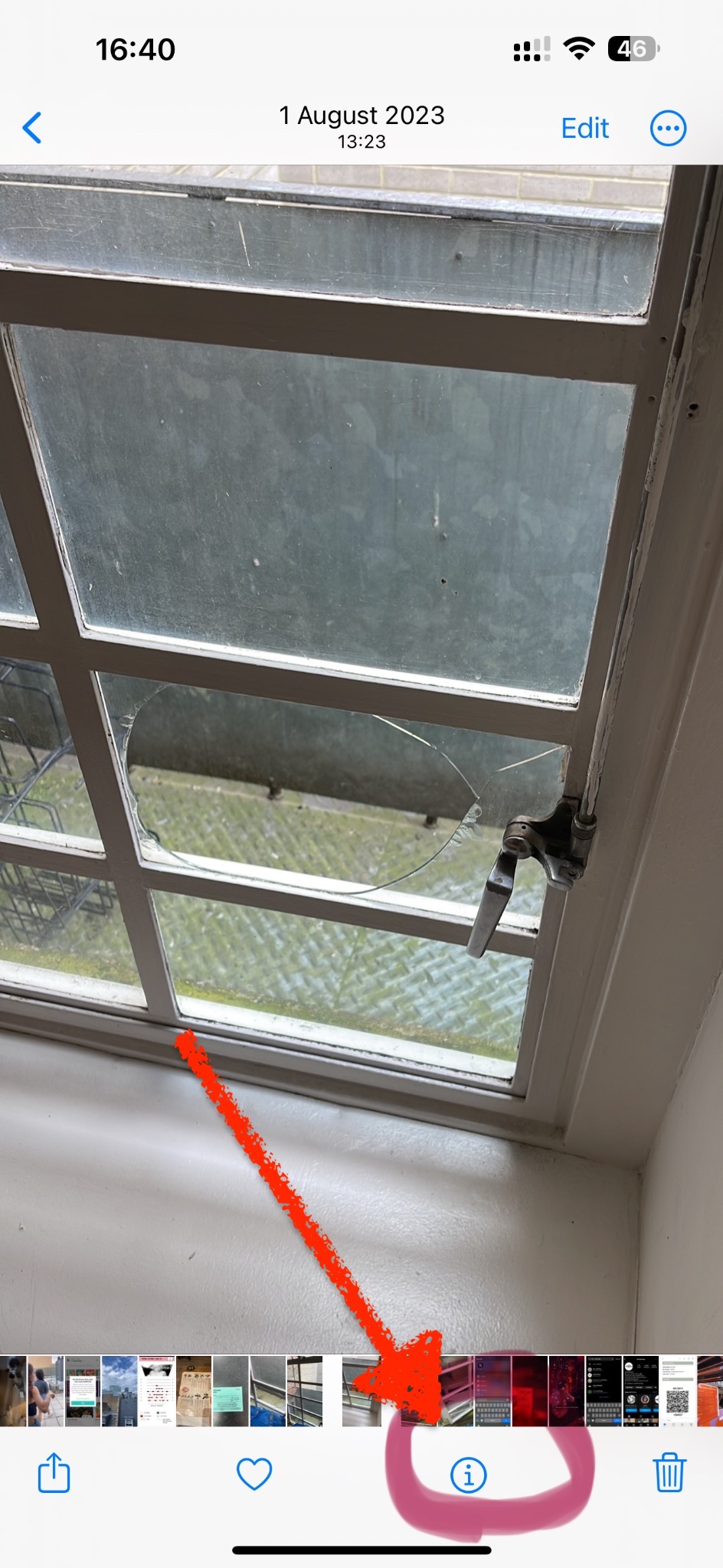
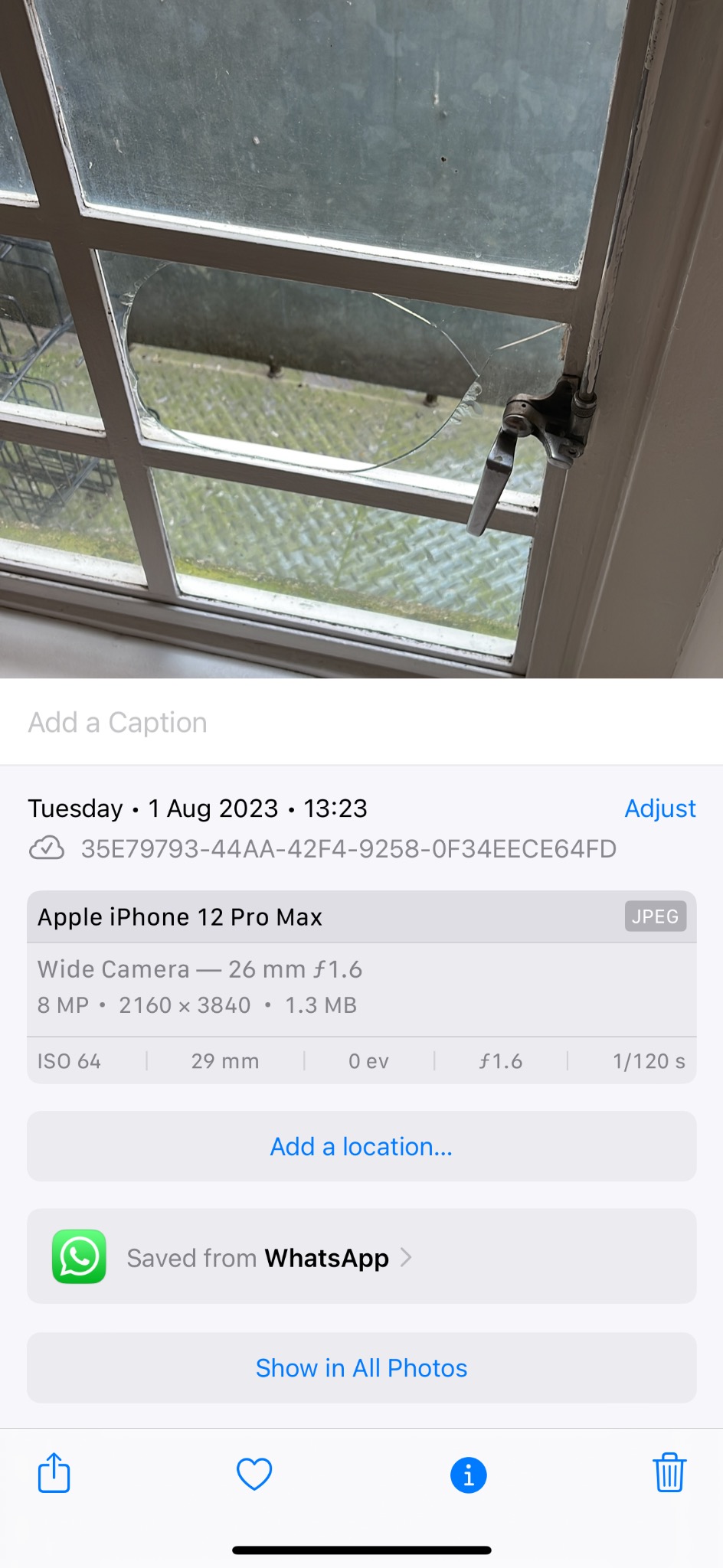
Android:
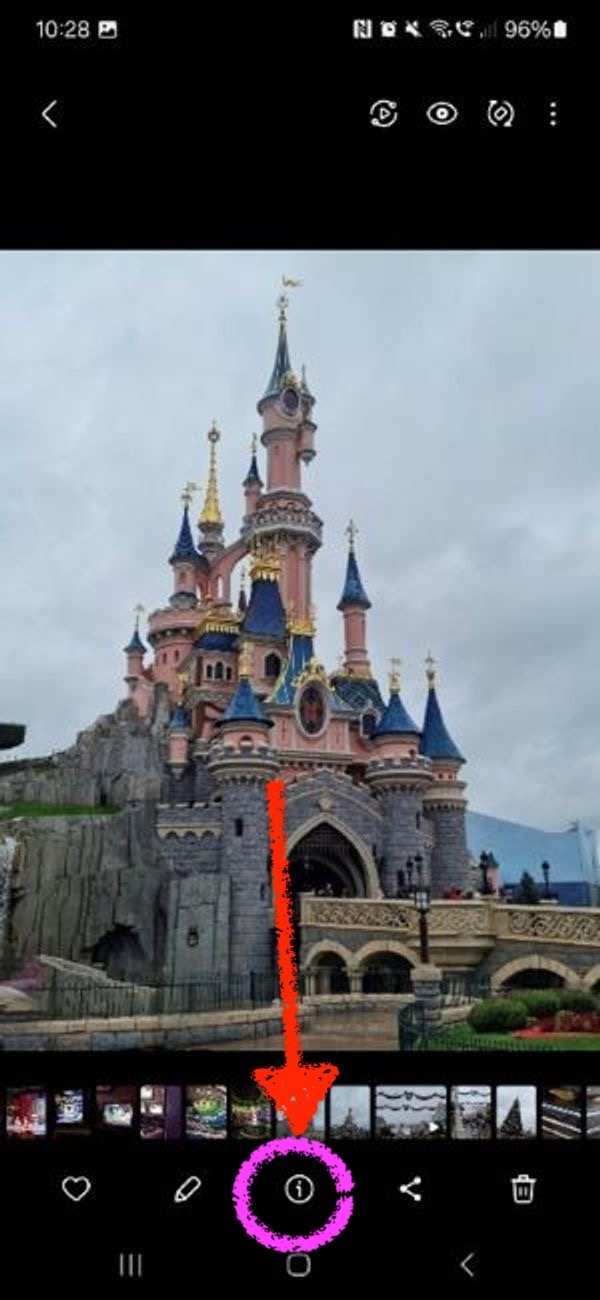

Invoices, receipts and quotes
Cost evidence is another crucial part of the incident submission process. By following these simple steps, you'll help process your incident report quickly and efficiently:
- Getting your estimate sorted: If you need repairs, getting at least 2 quotes from different companies can help you find the best price. Ask for the quotes on official company letterhead or email for Superhog's records.
- Owning it? Not a problem: To help process your incident, Superhog usually ask for the original purchase receipt as proof of ownership. But if you don't have it, no worries! They can use photos, bank statements, or even links to similar items online to verify.
- Making sense of bills: To make things crystal clear, all invoices or quotes should be from separate companies, not related to each other. And please break down the total cost into individual items, like labour and parts. This detailed view helps Superhog understand your expenses perfectly, ensuring a smooth and fair evaluation.
Damage Exclusion:
Cosmetic Damage
Cosmetic Damage means damage that does not impact the likelihood of a property receiving a booking, or adversely impact the functionality of the property’s fixtures and/or fittings, or its contents. By way of example (but not limited to) damage that consists solely of scratches, scuffs, marks or dents;
Such damage primarily impacts the appearance of an item without compromising its functionality.
Pet Damage:
Issues related to guests bringing pets are a frequent cause for resolution requests. In accordance with the clause outlined below, protection extends solely to damages caused by unauthorised pets, excluding authorised service animals:
3.1.11. Property Damage resulting from any pet (excluding service animals) permitted by the host to stay at the Property. You can view all clauses here.
When granting permission for pets in your properties, it is advisable to establish clear criteria for what you consider acceptable. This may include specifying the permissible number of dogs, acceptable sizes, or outlining specific breeds to avoid any potential misunderstandings between both hosts and guests.
The Incident Submission Process
Important: Superhog require instant notification of any discovered damages (ideally within 24 hours) and no later than 10 days from the guest’s check-out date. Any resolution requests outside of this window will NOT be accepted.
Superhog designed its process to be as quick and efficient as possible.
Their dedicated team of experienced reviewers work diligently to process resolutions promptly, with most receiving a decision within 48 hours of complete submission. You will receive clear communications throughout the process, keeping you informed every step of the way. The goal is to minimise disruption and get your rental back on the market quickly.
Reporting damage(s)
Upon discovering any damage, please register the problem within 24 hours and no later than 10 days from the end of the booking.
To report any damages, kindly follow this link and supply all the necessary information.
You should be viewing a page like this:
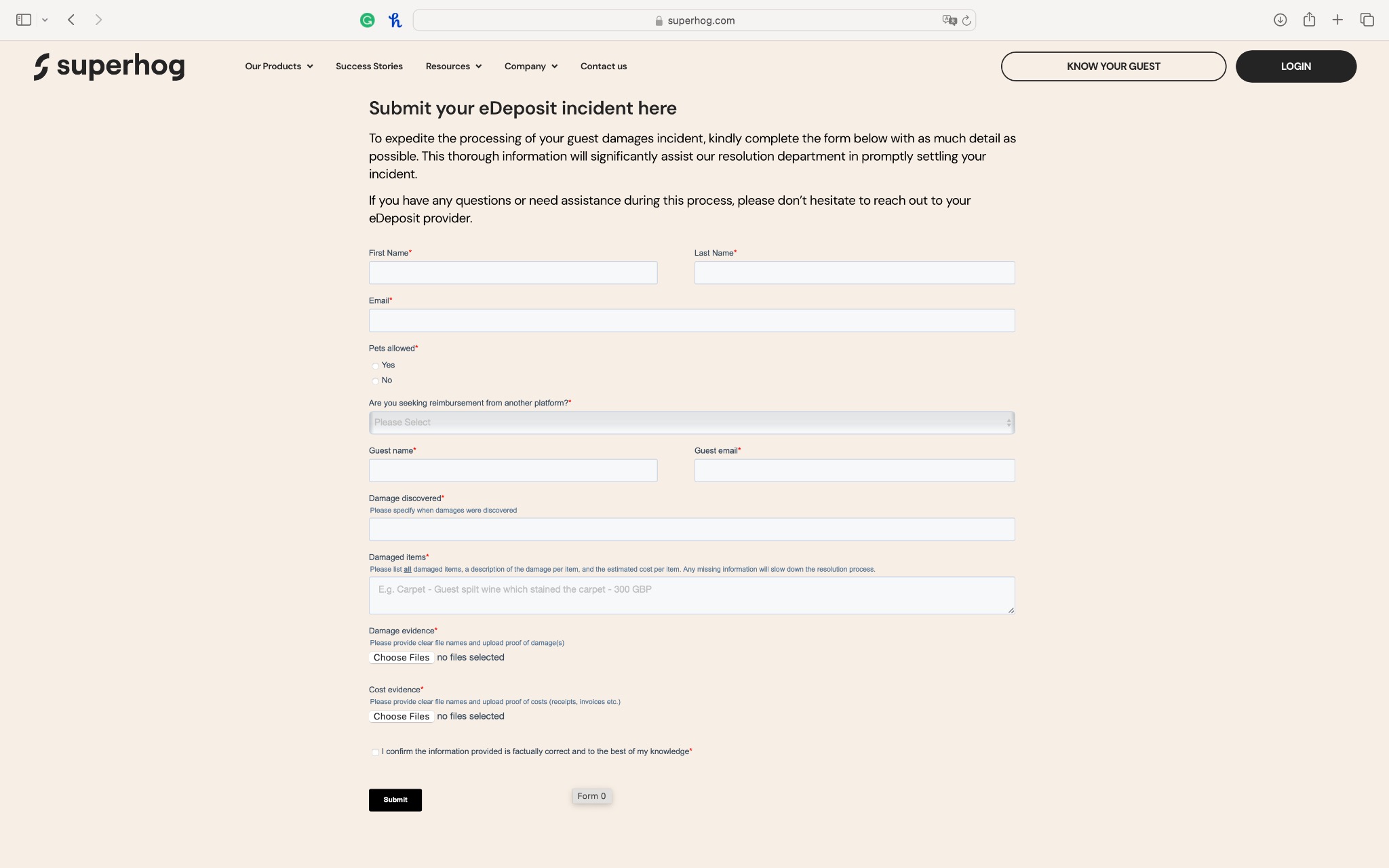
If your encounter any issues please reach out to info@houfy.com promptly.
Guest Liability
If a guest provides a written admission of liability for any damage caused, kindly share this information with Superhog promptly.
Doing so will greatly expedite the resolution process, enabling Superhog to proceed with efficiency and accuracy. Your cooperation in promptly passing along such admissions is valuable in ensuring a swift resolution.
Review and Decision
The resolution process follows a structured four-step approach:
1. Qualify:
- Assess whether the damage was caused by an approved guest during a booking.
- Verify if the damage meets specific qualifying criteria, particularly confirming that it was caused by the guest and not categorised as cosmetic damage or wear and tear.
2. Quantify:
- Determine the cost of the damage caused by the guest.
- Consider factors such as the replacement value of the item before the damage (accounting for reasonable depreciation) and evaluate available economic options for reinstating the damage.
- Superhog will thoroughly review the evidence you have submitted in comparison to the required evidence. If any crucial information or documentation is missing, they may reach out to you for additional details. This ensures that they have all the necessary information to make an accurate and fair incident offer. Your cooperation in providing any missing information is greatly appreciated, as it helps us in making well-informed decisions.
3. Settle:
- Finalise and settle the agreed-upon amount with the host. A document titled 'Resolution Settlement Decision' will be sent to you, providing confirmation of the acceptance or rejection of the resolution offer. This document will include a comprehensive summary outlining the rationale behind the decision and how they arrived at the conclusion.
- Deduct any contributions due from related parties, including deposits, damage waivers, etc.
- Payment will be made within 3-5 working days of receiving bank details
4. Recover:
- Initiate the recovery phase by approaching the guests to recoup the costs associated with reinstating the damage.
- While this is primarily Superhog's responsibility, they may on rare occasions seek your assistance.
This systematic approach ensures a comprehensive and fair resolution process for all parties involved.
Things to remember
- Always keep a record (typically a report or photographs) of the property immediately before and after each booking; without this, it can be hard to prove that damage happened during a booking.
- Make sure you contact us upon discovery of any damage or loss (no exceptions)
- Repair is always going to be suggested unless replacement is a more cost-effective option
- For carpets and flooring, Superhog will only pay the cost of replacing the damaged area (not a reason to replace the whole floor!)
- If Superhog makes a cash settlement for lost or damaged items, they may make a deduction for wear and tear
- Superhog or their representative may require access to the property during the resolution process
Need more help?
Try these next steps
